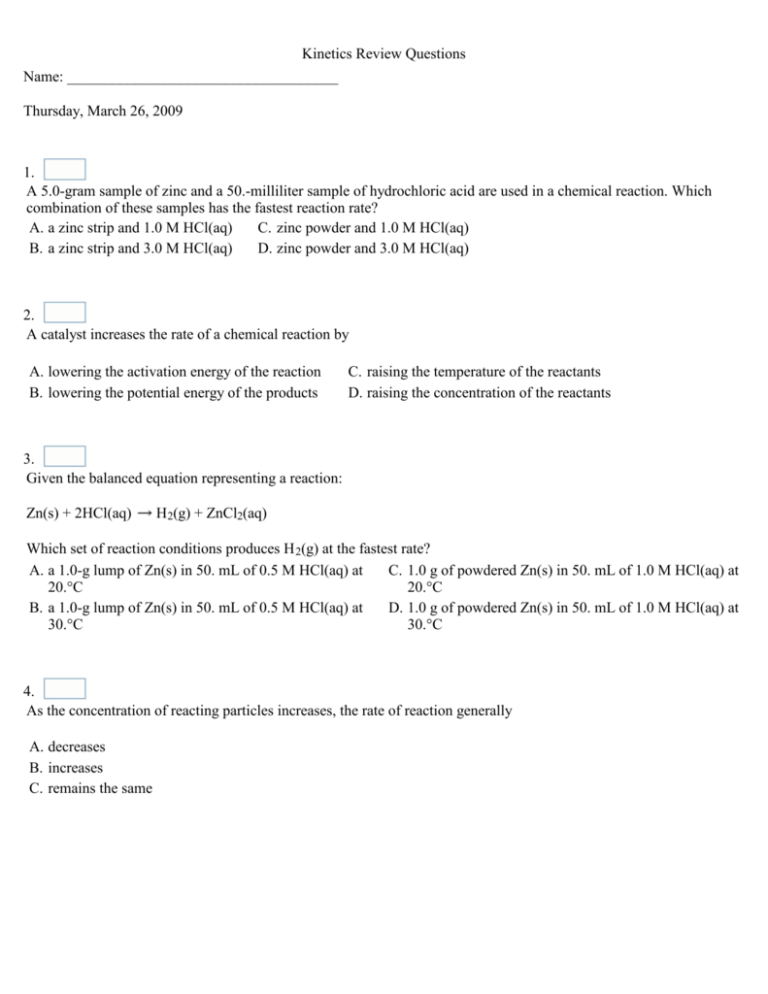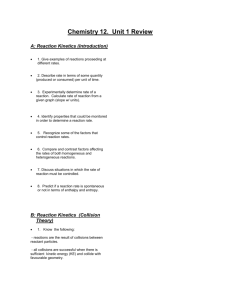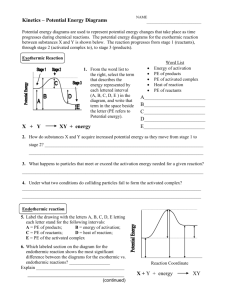Kinetics Review Questions Name: Thursday, March 26, 2009 1. A
advertisement

Kinetics Review Questions Name: ____________________________________ Thursday, March 26, 2009 1. A 5.0-gram sample of zinc and a 50.-milliliter sample of hydrochloric acid are used in a chemical reaction. Which combination of these samples has the fastest reaction rate? A. a zinc strip and 1.0 M HCl(aq) C. zinc powder and 1.0 M HCl(aq) B. a zinc strip and 3.0 M HCl(aq) D. zinc powder and 3.0 M HCl(aq) 2. A catalyst increases the rate of a chemical reaction by A. lowering the activation energy of the reaction B. lowering the potential energy of the products C. raising the temperature of the reactants D. raising the concentration of the reactants 3. Given the balanced equation representing a reaction: Zn(s) + 2HCl(aq) H2(g) + ZnCl2(aq) Which set of reaction conditions produces H 2(g) at the fastest rate? A. a 1.0-g lump of Zn(s) in 50. mL of 0.5 M HCl(aq) at C. 1.0 g of powdered Zn(s) in 50. mL of 1.0 M HCl(aq) at 20.°C 20.°C B. a 1.0-g lump of Zn(s) in 50. mL of 0.5 M HCl(aq) at D. 1.0 g of powdered Zn(s) in 50. mL of 1.0 M HCl(aq) at 30.°C 30.°C 4. As the concentration of reacting particles increases, the rate of reaction generally A. decreases B. increases C. remains the same Kinetics Review Questions 5. Given the reaction at 25°C: Zn(s) + 2 HCl(aq) → ZnCl2(aq) + H2(g) The rate of this reaction can be increased by using 5.0 grams of powdered zinc instead of a 5.0- gram strip of zinc because the powdered zinc has A. lower kinetic energy B. lower concentration C. more surface area D. more zinc atoms 6. Which statement explains why the speed of some chemical reactions is increased when the surface area of the reactant is increased? A. This change increases the density of the reactant particles. B. This change increases the concentration of the reactant. C. This change exposes more reactant particles to a possible collision. D. This change alters the electrical conductivity of the reactant particles. 7. Raising the temperature speeds up the rate of a chemical reaction by increasing A. the effectiveness of the collisions, only B. the frequency of the collisions, only C. both the effectiveness and the frequency of the collisions D. neither the effectiveness nor the frequency of the collisions 8. Based on the nature of the reactants in each of the equations below, which reaction at 25°C will occur at the fastest rate? A. C(s) + O2(g) → CO2 (g) B. NaOH(aq) + HCl(aq) → NaCl(aq) + H2O( ) C. CH3OH( ) + CH3COOH( ) → CH3COOCH3 (aq) + H2O( ) D. CaCO3(s) → CaO(s) + CO2 (g) Kinetics Review Questions 9. Which statement best explains the role of a catalyst in a chemical reaction? A. A catalyst is added as an additional reactant and is consumed but not regenerated. B. A catalyst limits the amount of reactants used. C. A catalyst changes the kinds of products produced. D. A catalyst provides an alternate reaction pathway that requires less activation energy. 10. Which factors must be equal in a reversible chemical reaction at equilibrium? A. the activation energies of the forward and reverse C. the concentrations of the reactants and products reactions B. the rates of the forward and reverse reactions D. the potential energies of the reactants and products 11. When a single 1-gram piece of zinc is added to 3 M hydrochloric acid at 25°C, the reaction is slow. Which procedure would most likely increase the rate of the reaction if the reaction were repeated? A. using 1 gram of powdered zinc B. using 1 M hydrochloric acid C. decreasing the temperature to 20.°C D. decreasing the concentration of the zinc 12. Adding a catalyst to a chemical reaction results in A. a decrease in activation energy and a decrease in the reaction rate B. a decrease in activation energy and an increase in the reaction rate C. an increase in activation energy and a decrease in the reaction rate D. an increase in activation energy and an increase in the reaction rate 13. When a catalyst is added to a chemical reaction, there is a change in the A. heat of reaction B. rate of reaction C. potential energy of the reactants D. potential energy of the products Kinetics Review Questions 14. How is a chemical reaction affected by the addition of a catalyst? A. The activation energy decreases. C. The number of collisions between particles decreases. B. The heat of reaction increases. D. The potential energy of the reactants increases. 15. Figure 1 A potential energy diagram is shown. Which reaction would have the lowest activation energy? A. the forward catalyzed reaction B. the forward uncatalyzed reaction C. the reverse catalyzed reaction D. the reverse uncatalyzed reaction 16. Which event must always occur for a chemical reaction to take place? A. formation of a precipitate B. formation of a gas C. effective collisions between reacting particles D. addition of a catalyst to the reaction system Kinetics Review Questions 17. In a chemical reaction, a catalyst changes the A. potential energy of the products B. potential energy of the reactants C. heat of reaction D. activation energy 18. Which statement must be true about a chemical system at equilibrium? A. The forward and reverse reactions stop. B. The concentration of reactants and products are equal. C. The rate of the forward reaction is equal to the rate of the reverse reaction. D. The number of moles of reactants is equal to the number of moles of product. 19. If a catalyst is added to a system at equilibrium and the temperature and pressure remain constant, there will be no effect on the A. rate of the forward reaction B. rate of the reverse reaction C. activation energy of the reaction D. heat of the reaction 20. A 1.0-gram piece of zinc reacts with 5 milliliters of HCl(aq). Which of these conditions of concentration and temperature would produce the greatest rate of reaction? A. 1.0 M HCl(aq) at 20.°C B. 1.0 M HCl(aq) at 40.°C C. 2.0 M HCl(aq) at 20.°C D. 2.0 M HCl(aq) at 40.°C Kinetics Review Questions 21. The potential energy diagram below represents a reaction. Which arrow represents the activation energy of the forward reaction? A. A B. B C. C D. D 22. Which change of phase is exothermic? A. NaCl(s) B. CO2(s) C. H2O(l) D. H2O(l) NaCl(l) CO2(g) H2O(s) H2O(g) Kinetics Review Questions 23. Figure 2 Base your answer to the questions on the potential energy diagram. What is the heat of reaction for the forward reaction? Answer: kJ 24. Given the potential energy diagram of a chemical reaction: Which arrow represents the potential energy of the reactants? A. A B. B C. C D. D Kinetics Review Questions 25. Which potential energy diagram represents an exothermic reaction? A. C. B. D. 26. Which phase change is an exothermic process? A. CO2(s) → CO2 (g) B. NH3 (g) → NH3( ) C. Cu(s) → Cu( ) D. Hg( ) → Hg(g) Kinetics Review Questions 27. The potential energy diagram for a chemical reaction is shown below. Each interval on the axis labeled "Potential Energy (kJ)" represents 40 kilojoules. What is the heat of reaction? A. -120 kJ B. -40 kJ C. +40 kJ D. +160 kJ 28. In a potential energy diagram, the difference between the potential energy of the products and the potential energy of the reactants is equal to the A. heat of reaction B. entropy of the reaction C. activation energy of the forward reaction D. activation energy of the reverse reaction Kinetics Review Questions 29. Figure 3 The potential energy diagram of a chemical reaction is shown. Interval B represents the A. potential energy of the products B. potential energy of the reactants C. activation energy D. activated complex 30. The combustion of propane is best described as an A. endothermic chemical change B. endothermic physical change C. exothermic chemical change D. exothermic physical change Kinetics Review Questions 31. Figure 4 The graph represents a chemical reaction. The reaction is best described as A. endothermic, because energy is absorbed B. endothermic, because energy is released C. exothermic, because energy is absorbed D. exothermic, because energy is released Kinetics Review Questions 32. Given the potential energy diagram for a chemical reaction: Which statement correctly describes the energy changes that occur in the forward reaction? A. The activation energy is 10. kJ and the reaction is C. The activation energy is 50. kJ and the reaction is endothermic. endothermic. B. The activation energy is 10. kJ and the reaction is D. The activation energy is 50. kJ and the reaction is exothermic. exothermic. 33. Assume that the potential energy of the products in a chemical reaction is 60 kilocalories. This reaction would be exothermic if the potential energy of the reactants were A. 50 kcal B. 20 kcal C. 30 kcal D. 80 kcal Kinetics Review Questions 34. Given the balanced equation: 4Fe(s) + 3O 2(g) 2Fe2O3(s) + 1640 kJ Which phrase best describes this reaction? A. endothermic with H = +1640 kJ B. endothermic with H = -1640 kJ C. exothermic with H = +1640 kJ D. exothermic with H = -1640 kJ 35. Given the reaction: S(s) + O2(g) SO2(g) + energy Which diagram best represents the potential energy changes for this reaction? A. C. B. D. 36. In which equation does the term "heat" represent heat of fusion? A. NaCl(s) + heat → NaCl(l) B. NaOH(aq) + HCl(aq) → NaCl(aq) + H2O(l) + heat C. H2O(l) + heat → H2O(g) + D. H2O(l) + HCl(g) → H3O (aq) + Cl (aq) + heat Kinetics Review Questions 37. Figure 5 Base your answer on the potential energy diagram of a chemical reaction. The forward reaction is best described as an A. exothermic reaction in which energy is released B. exothermic reaction in which energy is absorbed C. endothermic reaction in which energy is released D. endothermic reaction in which energy is absorbed 38. [Refer to figure 5 in question 37] Base your answer on the potential energy diagram of a chemical reaction. Which arrow represents the activation energy for the foward reaction? A. A B. B C. C D. D Kinetics Review Questions 39. Figure 6 Which interval in the potential energy diagram represents the heat of reaction? A. A B. B C. C D. D 40. According to Reference Table I, which statement best describes the formation of H2O(g)? A. It is exothermic, and heat is released. B. It is exothermic, and heat is absorbed. C. It is endothermic, and heat is released. D. It is endothermic, and heat is absorbed. 41. Which of these changes produces the greatest increase in entropy? A. CaCO3(s) → CaO(s) + CO2(g) B. 2 Mg(s) + O2(g) → 2 MgO(s) C. H2O(g) → H2O( ) D. CO2(g) → CO2(s) Kinetics Review Questions 42. At STP, a sample of which element has the highest entropy? A. Na(s) B. Hg( ) C. Br2( ) D. F2(g) 43. Which 10-milliliter sample of water has the greatest degree of disorder? A. H2O(g) at 120°C B. H2O( ) at 80°C C. H2O( ) at 20°C D. H2O(s) at 0°C 44. Which list of the phases of H 2O is arranged in order of increasing entropy? A. ice, steam, and liquid water C. steam, liquid water, and ice B. ice, liquid water, and steam D. steam, ice, and liquid water 45. Which sample has the lowest entropy? A. 1 mole of KNO3(l) B. 1 mole of KNO3(s) C. 1 mole of H2O(l) D. 1 mole of H2O(g) 46. Which 1-mole sample has the least entropy? A. Br2(s) at 266 K B. Br2( ) at 266 K C. Br2( ) at 332 K D. Br2(g) at 332 K Kinetics Review Questions 47. Systems in nature tend to undergo changes toward A. lower energy and less disorder C. higher energy and less disorder B. lower energy and more disorder D. higher energy and more disorder 48. Which reaction results in an increase in the entropy of a system? H2O(l) A. H2O(g) H2O(s) B. H2O(l) 2H2(g) + O2(g) C. 2H2O(l) 2H2O(l) D. 2H2(g) + O2(g) 49. Which phase change represents a decrease in entropy? A. solid to liquid B. gas to liquid C. liquid to gas D. solid to gas 50. In which system will there be a decrease in entropy as bromine undergoes a change in phase? A. Br2(s) B. Br2(g) C. Br2(l) D. Br2(s) Br2(l) Br2(l) Br2(g) Br2(g) Kinetics Review Questions Answer Key for Kinetics Review Questions 1. D 2. A 3. D 4. B 5. C 6. C 7. C 8. B 9. D 10. B 11. A 12. B 13. B 14. A 15. A 16. C 17. D 18. C 19. D 20. D 21. B 22. C 23. 80 24. B 25. B 26. B 27. C 28. A 29. C 30. C 31. D 32. B 33. D 34. D 35. A 36. A 37. D 38. A 39. B 40. A 41. A 42. D 43. A 44. B 45. B 46. A Kinetics Review Questions 47. B 48. C 49. B 50. B








